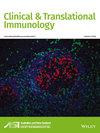SIRT7 ameliorates Th17/Treg imbalance by desuccinylation of STAT3 to improve immune thrombocytopenia
Abstract
Objectives
The imbalance of Th17/Treg cells represents a key pathogenic mechanism in immune thrombocytopenia (ITP); however, the underlying regulatory mechanisms remain poorly understood. Dysregulated succinylation has been implicated in disease onset and progression. Therefore, this study aimed to investigate the role of succinylation in modulating the Th17/Treg balance in ITP and to elucidate the associated molecular pathways.
Methods
Whole blood samples were collected from ITP patients and mouse models. The frequencies of Treg and Th17 cells were quantified using flow cytometry. Treg- and Th17-associated biomarkers were analysed via enzyme-linked immunosorbent assay, quantitative real-time polymerase chain reaction and immunoblotting. The regulatory relationship between SIRT7 and STAT3 succinylation was evaluated through co-immunoprecipitation, immunofluorescence and immunoblotting assays.
Results
Patients with ITP exhibited elevated Th17/Treg ratios, accompanied by increased global succinylation levels and reduced SIRT7 expression. Overexpression of SIRT7 restored the Th17/Treg imbalance in vitro. Mechanistically, SIRT7 overexpression suppressed STAT3 succinylation at K573, thereby inhibiting STAT3 activity and downstream signalling. Conversely, enforced STAT3 expression counteracted the effects of SIRT7 overexpression on Th17/Treg dynamics. In vivo experiments demonstrated that SIRT7 knockout exacerbated thrombocytopenia and further disrupted Th17/Treg homeostasis in murine models.
Conclusion
SIRT7 mitigates ITP progression by maintaining Th17/Treg equilibrium through desuccinylation of STAT3. These findings highlight SIRT7 as a potential therapeutic target for ITP treatment, offering novel insights into the epigenetic regulation of immune dysregulation in autoimmune diseases.


 求助内容:
求助内容: 应助结果提醒方式:
应助结果提醒方式:


